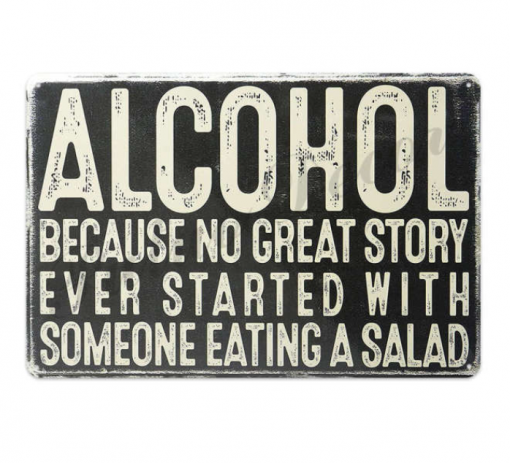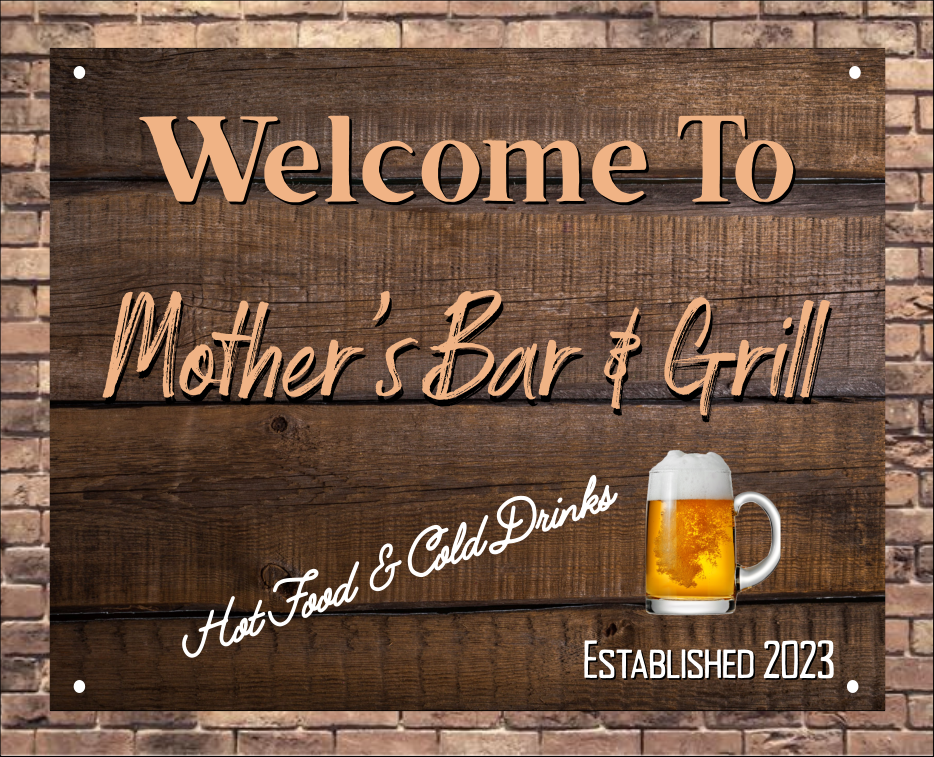Free Tips On Choosing Bar Signs
Wiki Article
How Do Bar Signs Differ In Regards To Location?
The location of bar signs is important. They are constructed, placed and purposed to be effective in specific locations. Here's a rundown of how bar signs differ depending on the location they're located: Exterior Signs
Use: To create an identity for your bar and draw new patrons.
Features: Big, eye at-tractive and frequently lit to enhance visibility at night.
Materials: Sturdy materials like neon, metal, LED or weather-resistant vinyl.
Signs above the entrance: Name of bar and logo, marquee, etc.
2. Entrance signs
The intention behind the welcome card is to provide information and to greet customers.
In most cases, with branding elements, the features are clear and inviting.
Materials: Wood signs, metal signs and illuminated signs.
The signs include "Welcome", operational hours, and announcements about special events.
3. Interior wall signage
Goal: To enhance the decor, provide information and create a mood.
Features: The dimensions and design of the rugs can be varied to suit any decor.
Materials: Wood, metal, chalkboard, acrylic.
Some examples: Menu boards, inspirational quotes and thematic decor signs.
4. Signs for Behind the Bar
Purpose: To highlight important elements like the bar's signature drinks, names, or specials.
Features: It is bright and well-lit and makes it a great focal zone.
Materials: neon, LED, digital display, chalkboard, or other materials.
Examples: Name signs for bars and drink specials boards and digital menu displays.
5. Signs for the ceiling and hanging
Purpose: To provide directional information or improve the design from above.
The ceiling is suspended and easily visible from different angles.
Materials: Lightweight substances like foam board, acrylic or steel.
For instance: hanging decorative signs and themed props.
6. Tabletop Signs
Use: Provide patrons with details specific to their table.
Features The display is easy to read from close-up.
Materials: Wood, acrylic, laminated paper.
Examples include drink menus and table numbers. Promotional cards, QR codes, and promotional stands.
7. Signs for Restrooms
Objective: To clearly display the exact location of toilets.
Specifications: Highly visible, often with clear texts and symbols.
Materials: Metal, plastic, wood.
Examples: Men's and female restroom signs, non-sex restroom signs.
8. Directional signs
The goal of the sign is to guide patrons towards different areas in the bar.
Highlights clear labels and arrows easily read.
Materials: Metal, acrylic, wood.
Examples: Signs pointing out bathrooms, exits and seating areas.
9. Window Signs
Objective: To make the bar more visible and also inform passers-by.
Features: Easily visible from the outside, and often with lighting.
Materials: Vinyl decals, neon, LED.
Examples: advertisements and promotional signs, event announcements and operating hours.
10. Promotional and Event Signs
Purpose: To inform patrons of special events and promotions or seasonal offers.
The features: Attractive, and occasionally temporary.
Materials Include: Foamboard, vinyl and chalkboard.
Example Banners and event posters.
Local Specific Beware of
Visibility
Signs for entry and exterior signs have to be extremely noticeable.
Signs for the inside and behind-the-bar area: They must be strategically placed to maximize impact and ease for reading.
Durability
Exterior Signs for the exterior. Materials must be weatherproof.
Interior signs are a great option since they can be created using a variety of different materials.
Aesthetic Integration
The signs behind the bar and decorative: They should complement the theme and style of the bar.
Informational and directional signs should be practical and fit in with the décor.
Functionality
Signs for restrooms and directions The signs should be easy to read and clear enough to enable patrons to navigate the area with ease.
The signs for event promoters and events are to be temporary or able to be changed to reflect the latest offers.
Lighting
Signs for windows and exteriors illuminated to increase visibility at night.
Interior and Behind-the-Bar Signs can use lighting to highlight specific areas or create an atmosphere.
Bar owners can create a welcoming atmosphere by customizing the design, material, and placement of bar signs. Check out the recommended his explanation on bar hanging sign for website info including the staying inn pub sign, modern pub sign, bar hanging sign, gin bar sign, pub signs to buy, bar signs for garden, personalised bar signs, personalised pub signs for garden, pub bar signs for sale, novelty bar signs and more.

How Do Bar Signs Differ In Terms Lighting?
Bar signs differ significantly in lighting which impacts their visibility, ambiance, and overall impact. Here are some of the main ways that lighting affects bar signs. Neon signs
Characteristics: Bright, colorful, classic.
Lighting: Utilizes neon-filled gas tubes that produce light when they are electrically charged.
Uses: Create a retro appearance with this type of material. It is frequently used to design bar names, logos and other attractive designs.
The nostalgic appeal as well as the high visibility make this a great choice.
It's fragile, and repairs are costly.
2. LED Signs
Characteristics: Energy-efficient, versatile, modern.
Lighting: Make use of LEDs to produce bright and vibrant lighting.
Uses: Can be used for indoor or outdoor signs, as well as display that can be programmed.
Benefits: LEDs are long-lasting, energy efficient, and they can be programmed to show animated or color changes.
Disadvantages: Can be expensive at first, but it can be a great savings on maintenance and energy costs.
3. Backlit Signs
Characteristics: Elegant, sophisticated, subtle.
Lighting: Uses lighting with fluorescent or LEDs on a translucent surface to create a soft glow.
Applications: Used for modern bar signage Menu boards and branding elements, for example.
Advantages It has an elegant, clean appearance and enhances reading in low light.
Advantages: Simpler installation, but a higher initial cost.
4. Signs with Edge-Lit
Characteristics: Sleek, contemporary, stylish.
Lighting: Lights up the edges of an acrylic sign panel.
Uses: Suitable for contemporary minimalist designs, commonly employed for informational or directional signs.
Features: Provides elegant unique designs. It's also energy efficient.
Advantages
5. Ambient/Accent Lighting
Characteristics: Subtle, atmospheric, decorative.
Lighting: Utilizes indirect lighting sources to highlight or emphasize the appearance of signs.
Uses Enhances the atmosphere. Often used to emphasize artwork or theme décor.
Benefits: Creates a warm and welcoming environment.
Negatives: Might not be able to provide enough direct illumination for reading.
6. Marquee signs
Characteristics: Bold, theatrical, eye-catching.
Lighting: Featuring numerous light bulbs or LEDs around the edges of the sign.
Uses: Popular as exterior signs, for event promotions and to create an old-fashioned look.
Benefits: High visibility and attention-grabbing.
The disadvantages are that it can be expensive and requires regular maintenance.
7. Projection Signs
Characteristics: Dynamic, innovative, versatile.
Lighting: Light and images are projected onto surfaces with projectors.
Uses: Great for promotions and events that require a short time, and dynamic displays.
Benefits: No physical sign structure is needed.
Advantages
8. Fluorescent Signs
Characteristics: Bright, cost-effective, traditional.
Lighting: Utilizes fluorescent tubes for illumination.
Commonly used to create bigger outdoor or indoor signs.
Large signs are attractive and bright and reasonably priced.
Negatives : They are less efficient in terms of energy efficiency than LEDs and can produce a harsher lighting.
Lights: Considerations for the Lighting
Visibility
Neon and LED Signs Excellent for attracting attention from a distance especially in low light.
Backlit and edge lit signs can greatly improve the reading ability and also creating a an appearance that is professional.
Energy Efficiency
LED Signs: High-energy-efficient. Long-lasting.
Neon and fluorescent signs Neon is not as energy efficient.
Aesthetic Appeal
Neon Signs and Marquees: Ideal for retro and vintage aesthetics.
Backlit and Edge-lit Signs are ideal for modern designs.
Ambient Lighting: Enhances the ambience and overall atmosphere.
Maintenance
LED Signs last and are low maintenance.
Neon and fluorescent signs require frequent maintenance and repair.
Cost
LED Backlit Signs: High initial cost, but lower operating costs.
The initial cost of fluorescent signs is lower but they cost more in energy costs over time.
Flexibility
Projection and Programmable Signs: Flexible display options for moving displays and dynamic content.
Traditional Signs: They are more difficult to alter, but they often achieve a particular style.
Bar owners can improve their bar's visibility and create the ambience they would like to create by selecting the right type of bar sign lighting. They also have the ability to communicate their brand or promotions as well as other details to patrons. Take a look at the best homepage for window vinyl for more advice including hanging pub signs personalised, personalised hanging bar sign, bar signs for home bar, large pub sign, personalised metal bar signs, personalised cocktail sign, personalised cocktail bar sign, bar sign hanging, personalised hanging bar sign, gin bar sign and more.
What Are The Distinctions In Bar Signposts That Pertain To Interactivity?
Bar signs can include different levels of interaction in order to attract customers and enhance their overall experience. Here's how bar signs differ in terms of interactivity:1. Static Signs
Static signs offer information in an unchanging format.
Common Types: Printed poster or painted murals as well as standard neon sign.
2. Digital Displays
Digital Signs permit multimedia content and real-time animations.
Interactivity: Touchscreens may include interactive games, menus, or promotional content.
Benefits: Captivate attention, convey dynamic information, and encourage the participation of patrons.
3. QR Codes
QR Codes can be linked directly to profiles on social media or menus.
Benefits: Provide quick access to information regarding promotions or loyalty programs.
4. LED Screens
Dynamic messaging: LED screens display animated text scrolling, scrolling or video clips.
Interactivity: LED screens that are touch-enabled let patrons interact with content like choosing menu items as well as playing games.
Benefits: Draw your audience's attention through creating experiences that are immersive.
5. Projection Mapping
Immersive experience Projection maps transform the surface into dynamic displays and interactive visuals, offering storytelling.
Patrons can interact by playing interactive games or interacting with virtual experiences.
Benefits: Make unforgettable experiences, increase the ambience, and promote social interaction.
6. Augmented Reality
AR (Enhanced Reality) overlays digital content over the physical environment to provide immersive experiences.
Interactivity: AR-enabled signs allow users to interact with virtual elements, like making cocktails or playing games online.
Benefits: Stand out from others by offering unique experiences and engaging patrons.
7. Motion Sensors
Motion sensors can detect motion and trigger interactive responses on the signage.
Interactivity: Signs respond to the movements of patrons by showing animations or changing the content. They can also provide specific messages.
Benefits Improve engagement, create an immersive environment, and surprise patrons.
8. Social Media Integration
Online Interaction: Signs that feature hashtags, or handles for social media can inspire customers to engage online.
Users-generated Content: Encourage patrons to post photos of the signage on social media platforms, extending the bar's reach and visibility.
Benefits: Foster community engagement, amplify brand recognition, and create content that is created by users.
9. Interactive Lighting
Dynamic Effects - LEDs and neon signs that respond to touch or sound, and even movement.
Interactivity: Signs can change hue and brightness or patterns depending on the patron's interaction or other environmental signals.
Benefits: Create immersive atmospheres, enhance ambiance, and attract attention.
10. Gamification
Interactive Games: Signs that include games that are interactive and challenge the user to entertain customers and encourage participation.
Offer incentives such as discounts or gift cards to those who complete challenges or win games.
Benefits: Increase dwell times encourage social interaction and encourage repeat visits.
Incorporating interactive elements into signage the bar's owners can create engaging experiences that captivate patrons, promote brand awareness, and distinguish their establishment from a competitive market. View the best hanging bar sign for more examples including pub signs to buy, small pub signs, home bar pub signs, garden bar signs, garden bar sign personalised, a bar sign, to the bar sign, garden pub signs, bar signs for home bar, personalised garden bar signs and more.
